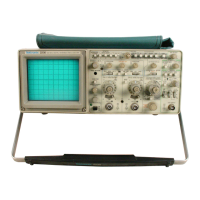General lnformation-2230 Operators
Finite resolution affects any measurement using
discrete numbers.
All
digital storage stores amplitude
values as discrete numbers
and
associates those ampli-
tude numbers with discretely numbered times. Many mea-
surements must
be
rounded or truncated. The size of the
truncation or rounding becomes a part of the measure-
ment error. For example, the following line
is
1.5 units
long. If it must
be
drawn
as
a
line
connecting points one
unit apart, then it may
be
drawn
as
a line one unit long or
two units long, depending
on
how it occurs relative to the
points.
Case 1:
Line
approaches three points:
Input line
Measurement resolution
Output
line
Case
2:
Line
approaches two points:
Input line
Measurement resolution
Output
line
There
are
several places where measurements
are
quantified,
and
a one-count error
in
the measurement can-
not
be
detected.
The
input channels are digitized to
an
8-
bit resolution, where one division is (ignoring expansion
and compression)
25
counts. This means there
is
an
inherent error
of
1 /25 of a division
in
any voltage measure-
ment at acquisition time. Averaging
can
increase the reso-
lution of a voltage measurement above the sampler's
eight-bit limit. To use the increased resolution, the display
has a 10-bit dynamic range
in
the vertical axis,
as
well
as
1-2
the horizontal axis.
An
averaged signal has a resolution of
100 points per division (ignoring expansion
and
compres-
sion).
In
addition, the averaged number
is
stored with up
to twelve bits of resolution. Expansion
is
required to view
the eleventh
and
twelfth bits of increased resolution.
Time
is
quantified to determine when
each
sample
occurred
and
which display interval gets
each
sample.
Time
is
resolved by storing, for example,
4K
points. If 4K
points are stored, 4K time intervals
are
represented. How-
ever,
in
4K mode, not
all
of the 4K-point resolution may
be
displayed
on
the 10-bit
(1
K-point) screen. Therefore, if 4K
COMPRESS
is
selected to present the whole picture on-
screen at once, only 1 K resolution remains
in
the display.
When peak-detected information
is
acquired, events with
high-frequency content
such
as
fast steps, or short pulses,
can only
be
located within the time interval from which the
peaks came.
Even
though two display points result from
the interval, the event cannot
be
tied with certainty to the
first or second point
in
the interval.
Time
is
also quantified to determine where to put points
in
REPETITIVE acquisitions, where the points acquired at
50 ns intervals fill only part of the screen. A counting
device produces a number to represent the portion of
50 ns between the samples acquired
and
the ones that
would have included the trigger. This number ranges from
0 to about 205, which allows accurate placement into the
display record.
The
display record will have at most 100
slots to choose from
on
the basis of the 0-205 number - ""'!
(this
is
where
each
slot represents 0.5
ns
of acquisition
time,
and
the counter's resolution
is
about 0.244
ns
per
count).

